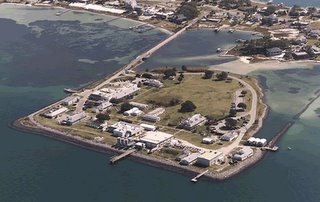 Sad to say, the annual Earth Day activities at the Gulf Ecology Division ("GED") on Pensacola Beach are being canceled this year. An on-line announcement explains:
Sad to say, the annual Earth Day activities at the Gulf Ecology Division ("GED") on Pensacola Beach are being canceled this year. An on-line announcement explains:Since many of the GED volunteer staff involved in the Earth Day preparations, collection of specimens, and presentations are participating in the Gulf of Mexico Hypoxia Survey from April 4-18, 2006, the student visits for 2006 have been cancelled.Skipping Earth Day at the GED on Pensacolsa Beach is worse than merely losing one field day trip for school children. Earth Day Week traditionally has been the one time every year when the Gulf Ecology Division opened its doors -- or at least, some of its doors -- to the general public. The GED not only uses the occasion to cleverly educate children about the important scientific work they do, but it goes a long way toward dispelling the faint whiff of mystery that many islanders think hangs over the facility.
The Gulf Environmental Division is one of only four pure scientific research centers in the nation established by the U.S. Environmental Protection Agency. (The others are in Rhode Island, Duluth, and Corvallis, Or.) In addition to a permanent staff of research scientists and support staff, GED hires on contract graduate students and post-grad researchers from around the world.
The division conducts pure scientific research into such matters as "ectotoxicology," the "ecological condition of estuaries and coastal waters," global temperature change, and "habitat alteration, nutrients, suspended and bedded sediments, pathogens and toxic chemicals that will support designated uses for aquatic systems." In other words, the biology and ecological environment of the entire Gulf of Mexico and its associated wetlands and waterways. Some of the scientists there also have been prominent research scientists studying the ecological effects of water-way disasters like the Exxon-Valdez oil spill.
It's a bit silly that island myths about the facility have grown up over the years. The "EPA," as islanders call it for short, is located on a small spit of land known as Sabine Point near the center of Pensacola Beach. It's out in the open for all to see as you cross the Bob Sikes toll bridge to the island. On closer inspection, however, it does look different from anything else on Pensacola Beach. The reason is it's --
"a man made island of sixteen and a half acres, formed from ballast brought by sailing ships during the late 1800's. It has the form of a basin which has been filled by an international mixture of rocks, coral, pottery and soil.Almost no locals actually visit the EPA facility. And it wouldn't do much good to try. The general public is excluded without advance appointment and things haven't gotten any better since 9-11.On the island, there is a deposit of black earth carried by barge from Louisiana which accounts for the luxuriant growth of oleander, fig trees and other flora in sharp contrast to the appearance of plant life in the glacial quartz deposits of "sugar white sand" on nearby Santa Rosa Island."
Once inside the grounds, even those who have business there are kept away from higher security buildings where ocean-related toxins and other dangerous chemicals are housed.
It may be true that GED as an institution, and many of its staff as individuals, haven't had a lot to do with the Pensacola Beach community. But the agency doesn't exactly keep itself hidden, either. The agency's web site offers detailed instructions for how to find it.
The simple truth is the EPA people are very busy taking the measure of how badly we're screwing up the environment. As the Earth Day announcement indicates, many of its personnel now have been assigned to a "Hypoxia Watch" a multi-year project which has been studying the effects of all that farmland fertilizer washing down the Mississippi into the Gulf of Mexico.
This year, it's a good guess they will find Hurricanes Katrina and Wilma stirred the pot quite a bit. But what effect that has on the alarming trend in diminished oxygen content of Gulf waters and the so-called "Dead Zone" has yet to be determined.
Once this year's survey is done, it would be nice if GED officials could find it in their hearts to schedule a local do-over Earth Day visit for the children -- and those of us who are children at heart. There are few more interesting sites to visit on Pensacola Beach.







No comments:
Post a Comment